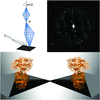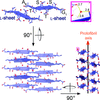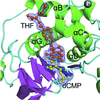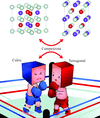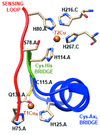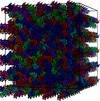issue contents
March 2019 issue

editorial
BIOLOGY | MEDICINE
Despite extraordinary advances in the options available for instant electronic communication, the argument is made that conferences still provide a unique forum for transmission of new ideas and advances in science, with their ability to inspire attendees.
scientific commentaries
NEUTRON | SYNCHROTRON
Atomic pair distribution (PDF) analysis has proven to be an exceptionally robust tool for probing the structure of amorphous, crystalline and crystallographically challenged materials. This issue of IUCrJ features a significant step forward in X-ray PDF methodology for thin films, with substantial improvements in both sensitivity and time resolution.
topical reviews
CHEMISTRY | CRYSTENG
The first systematic study is presented of π interactions between non-aromatic rings, based on the authors' own results from an experimental X-ray charge-density analysis assisted by quantum chemical calculations. The study includes quinoid rings, planar organic radicals and metal chelates. The stacking observed covers a wide range of interactions and energies, ranging from weak dispersion to unlocalized two-electron multicentric covalent bonding (`pancake bonding').
BIOLOGY | MEDICINE
The expanding toolkit of structural biology, with further advances in the technologies associated with cryoEM, synchrotrons and XFELs, and the ease of their use, should continue to enable the wider community to address more complicated and demanding scientific questions, ensuring the `pole position' of structural biology.
research papers
CRYO | EM
Stepwise nanobeam precession-assisted electron diffraction allows the structure determination of macromolecular nanocrystals, while limiting radiation damage. A new monoclinic polymorph of lysozyme was revealed and analyzed.
MATERIALS | COMPUTATION
Robust control of magnetism in LaAO3/BaTiO3 (A = Fe, Mn, Cr) perovskite superstructures is realized. Not only magnetism switching but also a spin-polarized 2D electron gas is created by switching of the polarization. A powerful scheme to realize robust control of both magnetism and the 2D electron gas is demonstrated. This work highlights the direction of further development in the multiferroic field.
CRYO | EM
The atomic asymmetry, left- or right-handedness, that is present in macromolecules and that was first described by Pasteur in his experiments with tartaric acid is evident even in complex molecular assemblies such as amyloid fibrils. Here, using the cryo-EM method MicroED, it is shown that a segment from the ice-nucleation protein InaZ assembles into homochiral and racemic water-binding amyloid protofibrils.
BIOLOGY | MEDICINE
The structure of dCMP hydroxymethylase from bacteriophage T4 in complex with the substrate dCMP and cofactor THF was determined at 1.9 Å resolution, providing the first view of the ternary complex of a pyrimidine hydroxymethylase.
MATERIALS | COMPUTATION
Two kinds of competition between different Heusler structure types are explored. The first is the competition between XA and L21 structures based on the cubic system of full-Heusler alloys of Pd2YZ and the second is the competitive mechanism between the L21 cubic system and its L10 tetragonal system.
CHEMISTRY | CRYSTENG
Download citation


Download citation


A new approach to understanding the chromic properties of crystals was tested on (pseudo)polymorphs of tyraminium violurate with large solvatochromic and crystallochromic effects, extreme birefringence, and crystal-to-crystal phase transition.
CHEMISTRY | CRYSTENG
PAF, a small cationic antifungal protein has been co-crystallized with a series of anionic calixarenes to reveal novel interaction modes. The largest ligand, sulfonato-calix[8]arene, yielded a PAF dimer in both the solid state and the solution state.
BIOLOGY | MEDICINE
TsNirK is the first three-copper three-domain nitrite reductase harbouring Gln-coordinated type 1 copper centres. All the structural properties of TsNirK point to an enzyme that, despite having several of the essential catalytic features present in other NirKs, shows two distinctive and unique characteristics: firstly, the putative T1CuC → T1CuN → T2Cu electron-transfer pathway along the same subunit; and secondly, more importantly, is the presence of the SerCAT residue at the enzyme substrate sensing loop, which opens a new paradigm in this widely studied family of enzymes.
PDB reference: copper-nitrite reductase (NirK) 6hbe
MATERIALS | COMPUTATION
The development of well ordered nanonetwork materials from basic building blocks to the bulk phase is examined by simplifying the scattering from the form factor of a sphere convoluted with the nodes of the structure factor, providing a simple methodology for studying the formation of well ordered nanonetwork materials.
NEUTRON | SYNCHROTRON
Microcalcifications are important pathological markers. Thus, it is relevant to study the occurring crystalline phases, their formation mechanisms, and the correlations between their structure and pathologic modifications of human tissue. Combining scanning X-ray microdiffraction and small-angle scattering reveals the crystalline phases of microcalcifications, and the abundance and orientation of collocated fibrous tissues (elastin, collagen, myofilament), spatially resolved over aneurysm tissue samples.
BIOLOGY | MEDICINE
Diffuse scattering is caused by correlated motions in protein crystals and is a potential source of information on protein dynamics. Although internal motional models were able to reproduce the diffuse scattering to a limited extent in earlier research, it is shown here that by far the most dominant contribution is from rigid-body translations, with internal motions contributing only a small part to the total scattering. Possibilities for extracting information on internal motions, despite these findings, are discussed.
NEUTRON | SYNCHROTRON
The short- and long-range order of thin films with thicknesses down to 3 nm were studied by applying PDF analysis to data collected by surface high-energy X-ray diffraction at a time resolution on the scale of seconds.
NEUTRON | SYNCHROTRON
During thin-film deposition by radio-frequency magnetron sputtering reliable high-energy grazing-incidence X-ray scattering data are obtained. In situ pair distribution function analysis is achieved allowing the deposition process to be investigated.
NEUTRON | SYNCHROTRON
Download citation


Download citation


The combination of oscillation data collection with fixed-target microchips for regular crystal dispersion is an efficient method for collecting serial crystallography data at synchrotrons. Background scatter from noncrystal substrates is especially minimized.
BIOLOGY | MEDICINE
The co-crystal structure of the metallopeptidase astacin with its specific protein inhibitor fetuin-B reveals a novel mechanism of inhibition.
PHYSICS | FELS
The performances of three image-classification algorithms were evaluated. The three classification methods lead to different datasets and subsequently result in different electron density maps of the reconstructed models.



 journal menu
journal menu




 access
access









